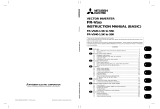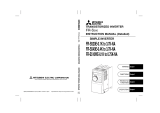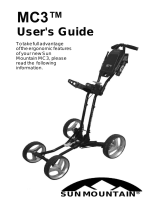
II
3.3.1 Parameter checking 47
3.3.2 Main parameter settings 49
3.4 Operation 51
3.4.1 Pre-operation checks 51
3.4.2 External operation mode (Operation using external input signals) 52
3.4.3 PU operation mode (Operation using the operation panel (FR-DU04)) 53
3.4.4 Combined operation mode (Operation using the external input signals and PU) 54
4 PARAMETERS 55
4.1 Parameter List 55
4.1.1 Parameter list 55
4.1.2 List of Parameters Classified by Purposes of Use 60
4.2 Parameter Function Details 61
4.2.1 Torque boost (Pr. 0, Pr. 46) 61
4.2.2 Output frequency range (Pr. 1, Pr. 2) 62
4.2.3 Base frequency, base frequency voltage (Pr. 3, Pr. 19, Pr. 47) 63
4.2.4 Multi-speed operation (Pr. 4 to Pr. 6, Pr. 24 to Pr.27) 64
4.2.5 Acceleration/deceleration time (Pr. 7, Pr. 8, Pr. 20, Pr. 21, Pr. 44, Pr. 45) 65
4.2.6 Electronic overcurrent protection (Pr. 9) 66
4.2.7 DC dynamic brake (Pr. 10 to Pr. 12) 67
4.2.8 Starting frequency (Pr. 13) 68
4.2.9 Load pattern selection (Pr. 14) 69
4.2.10 Jog operation (Pr. 15, Pr. 16) 70
4.2.11 MRS input selection (Pr. 17) 71
4.2.12 Stall prevention (Pr. 22, Pr. 23, Pr. 66, Pr. 148, Pr. 149, Pr. 154) 72
4.2.13 Multi-speed input compensation (Pr. 28) 73
4.2.14 Acceleration/deceleration pattern (Pr. 29, Pr.140 to Pr.143) 74
4.2.15 Regenerative brake duty (Pr.30, Pr.70) 75
4.2.16 Frequency jump (Pr. 31 to Pr. 36) 76
4.2.17 Speed display (Pr. 37, Pr. 144) 77
4.2.18 Automatic torque boost (Pr. 38, Pr. 39) 78
4.2.19 Up-to-frequency sensitivity (Pr. 41) 78
4.2.20 Output frequency detection (Pr. 42, Pr. 43, Pr. 50) 79
4.2.21 Second stall prevention (Pr. 48, Pr. 49) 80
4.2.22 Monitor display / FM, AM terminal function selection (Pr. 52 to Pr. 54, Pr. 158) 81
4.2.23 Monitoring reference (Pr. 55, Pr. 56) 83
4.2.24 Automatic restart after instantaneous power failure (Pr. 57, Pr. 58, Pr. 162 to Pr. 165) 84
4.2.25 Remote setting function selection (Pr. 59) 86
4.2.26 Intelligent mode selection (Pr. 60) 88
4.2.27 Acceleration/deceleration reference current/lift mode starting frequency (Pr. 61 to Pr. 63) 89
4.2.28 Retry function (Pr. 65, Pr. 67 to Pr. 69) 90
4.2.29 Applied motor (Pr. 71) 92
4.2.30 PWM carrier frequency (Pr. 72, Pr. 240) 93
4.2.31 Voltage input (Pr. 73) 94
4.2.32 Input filter time constant (Pr. 74) 95
4.2.33 Reset selection/PU disconnection detection/PU stop selection (Pr. 75) 95
4.2.34 Alarm code output selection (Pr. 76) 97
4.2.35 Parameter write inhibit selection (Pr. 77) 98

























